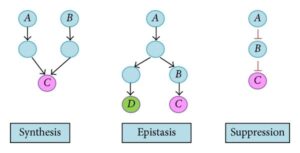Gene Interaction Punnett Square Calculator
Explore the complexity of genetic inheritance with our Gene Interaction Punnett Square Calculator. This advanced genetics tool helps you model how two or more genes interact to influence a single trait—something that traditional Punnett squares often overlook. Whether you’re a biology student, researcher, or educator, this tool provides a deeper understanding of real-world genetics. Browse additional inheritance calculators and genetics tools on our main site.
What Are Gene Interactions?
In classical Mendelian genetics, traits are typically controlled by a single gene. But in reality, many traits result from interactions between multiple genes. These interactions can modify phenotypic expressions in surprising ways, producing outcomes that deviate from simple dominant-recessive patterns.
Types of gene interactions include:
- Epistasis (one gene masks or modifies another)
- Complementary genes
- Duplicate genes
- Inhibitory genes
- Additive effects (where multiple genes contribute to a single phenotype)
Understanding these interactions is essential for accurately predicting phenotypes and inheritance patterns.

Why Use a Gene Interaction Punnett Square Calculator?
Traditional Punnett squares focus on single-gene crosses. However, real-world traits often involve gene interplay. Our Gene Interaction Calculator enables you to:
- Simulate and visualize how multiple genes interact
- Predict phenotypic outcomes based on gene relationships
- Explore non-Mendelian inheritance patterns
- Adjust for dominance, epistasis, and suppression
It’s a must-have for geneticists, biology students, and teachers looking to dive into the mechanics of gene regulation and expression.
How It Works
- Select the interaction type (e.g., epistatic, complementary, additive).
- Enter the genotypes of the parent organisms (e.g., AaBb, AABB).
- The calculator generates:
- A Punnett square showing all genotype combinations
- Corresponding phenotypes based on interaction rules
- Modified phenotypic ratios that result from gene interplay
The tool makes it easier to understand how traits are influenced by more than one gene, and why expected outcomes can differ from simple 9:3:3:1 ratios.
Key Features
- Supports various types of gene interactions
- Visualizes complex Punnett squares with accurate phenotype prediction
- Customizable input for flexible use in labs or classrooms
- Designed for genetics students, teachers, and professionals
- Compatible with standard dihybrid and modified dihybrid ratios
FAQs
What is the difference between gene interaction and epistasis?
Epistasis is a specific type of gene interaction where one gene masks another. Gene interaction is a broader term encompassing various ways genes influence each other.
Can this tool model traits like flower color or coat texture?
Yes! It’s ideal for modeling such multi-gene influenced traits, including examples from plants, animals, and humans.
Is this calculator suitable for more than two genes?
Currently, it focuses on two-gene interactions, which are standard in educational and research models. For more complex analysis, advanced tools may be needed.
Final Thoughts
Genetic inheritance isn’t always simple—and that’s what makes it fascinating. The Gene Interaction Punnett Square Calculator gives you a hands-on way to explore the science behind traits that are governed by multiple genes. From classroom learning to real-world applications, this tool empowers you to go beyond Mendel and understand how genes truly work together.
Try it today and unlock a deeper layer of genetic understanding.
